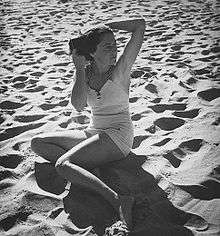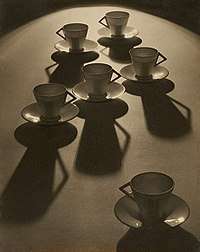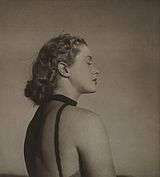Olive Cotton
Olive Cotton (11 July 1911 – 27 September 2003) was a pioneering Australian modernist female photographer of the 1930s and 1940s working in Sydney. Cotton became a national "name" with a retrospective and touring exhibition 50 years later in 1985. A book of her life and work, published by the National Library of Australia, came out in 1995. Cotton captured her childhood friend Max Dupain from the sidelines at photoshoots, e.g. "Fashion shot, Cronulla Sandhills, circa 1937" and made several portraits of him.[2] Dupain was Cotton's first husband.
Olive Cotton | |
|---|---|
 Cotton at the beach, taken by Max Dupain circa 1930s | |
| Born | Olive Edith Cotton 11 July 1911 Sydney, Australia |
| Died | 27 September 2003 (aged 92) Cowra, Australia |
| Nationality | Australian |
| Education | University of Sydney |
| Known for | Photography |
| Spouse(s) | Max Dupain ( m. 1939–1944) |
The prestigious Olive Cotton Award for Photographic Portraiture was set up in her honour and funded by Cotton's family and held at the Tweed regional gallery in New South Wales.
Early life
Olive Edith Cotton was born on 11 July 1911,[3][4] the eldest child in an artistic, intellectual family. Her parents, Leo and Florence (née Channon) provided a musical background along with political and social awareness.[5] Her mother was a painter and pianist while Leo was a geologist, who took photographs on Sir Ernest Shackleton's expedition to the Antarctic in 1907. The Cotton family and their five children lived in the then bushland suburb of Hornsby in Sydney's north. An uncle, Frank Cotton was a professor of physiology[6] and her grandfather, also Frank Cotton, was a Member of Parliament in the first Labor Caucus.[2]
Given a Kodak No.0 Box Brownie camera at the age of 11, Cotton with the help of her father made the home laundry into a darkroom "with the enlarger plugged into the ironing light".[5] Here Cotton processed film and printed her first black and white images. While on holidays with her family at Newport Beach in 1924, Cotton met Max Dupain and they became friends, sharing a passion for photography. The photograph "She-oaks" (1928) was taken at Bungan Beach headland in this period.
Cotton attended the Methodist Ladies' College, Burwood in Sydney from 1921 to 1929,[7] gained a scholarship and went on to complete a B.A. at the University of Sydney in 1933, majoring in English and Mathematics; she also studied music and was an accomplished pianist with a particular fondness for Chopin's Nocturnes.
Photography
Cotton joined The Sydney Camera Circle and the Photographic Society of New South Wales, gaining instruction and encouragement from important photographers such as Harold Cazneaux.
She exhibited her first photograph, "Dusk", at the New South Wales Photographic Society's Interstate Exhibition of 1932. She exhibited quite frequently, her photography was personal in feeling with an appreciation of certain qualities of light in the surroundings. After university she pursued photography by joining Dupain at his new studio, 24 Bond Street, Sydney. Her contemporaries included Damien Parer, Geoff Powell, the model Jean Lorraine and photographer Olga Sharpe, who frequented the studio.
In Australia during the 1930s clients assumed a man would be the photographer. Cotton wryly referred to herself as "the assistant".[2] However whenever possible Cotton photographed visiting celebrities or interesting objects in the studio, even capturing Dupain working in her piece, "Fashion shot, Cronulla Sandhills, circa 1937" and made portraits of him.[2] The publisher Sydney Ure Smith gave her many commissions, and regarded her as one of the best photographers of the 1930s and 1940s.
During the 1930s Cotton developed mastery using the 'Pictorial' style of photography popular at the time and also incorporated a very modern style approach.[4]
The Commonwealth Bank's staff magazine Bank Notes featured Cotton's more non-commercial photographs as illustrations.
Signature photographs


Tea cup ballet (1935) was photographed in the studio after Cotton had bought some inexpensive china from Woolworth's to replace the old chipped studio crockery. In it she used a technique of back of the lighting to cast bold shadows towards the viewer to express a dance theme between the shapes of the tea cups, their saucers and their shadows. It was exhibited locally at the time and in the London Salon of Photography in 1935.[5] It has become Cotton's signature image and was acknowledged on a stamp commemorating 150 years of photography in Australia in 1991. Tea cup ballet features on the cover of the book Olive Cotton: Photographer published by the National Library of Australia in 1995.[5]
Shasta Daisies (1937) and The Budapest String Quartet (c. 1937) were included in the Victorian Salon of Photography exhibition of 1937.
In 1939 Cotton married her longtime friend Max Dupain. They separated in 1941 and were divorced in 1944.[3]
Cotton received numerous commissions in 1945, including photographs of winter and spring flowers for Helen Blaxland's book Flowerpieces, which also included some images by Dupain.[2] Sydney Ure Smith was an advocate of her work, and she did many commissions for his various art publications.
In mid-1947 Cotton went to live in the bush 35 km from Cowra, New South Wales, with her new husband Ross McInerney. They lived in a tent for the first three years, then moving to a small farm where their two children grew up. She taught Mathematics at Cowra High School for five years until 1964 when she opened a small photographic studio in the town, taking many portraits, wedding photographs, etc., for people in the surrounding district, where her work became well-known and much appreciated, although she was as yet unknown on the postwar city art scene until 1985.
Exhibitions
Among others, her work was shown in the following exhibitions:
- 1938 Commemorative Salon of Photography exhibition held by the Photographic Society of NSW as part of the Australian 150th anniversary celebrations.
- 1938 Group show with the Contemporary Camera Groupe at David Jones Gallery, Sydney.
- 1981 Australian Women Photographers 1890-1950 touring exhibition, curated by Jenni Mather, Christine Gillespie and Barbara Hall.
- 1985 Olive Cotton Photographs 1924-1984 retrospective held at the Australian Centre for Photography, Sydney, touring numerous regional galleries in NSW, Victoria and Queensland throughout 1986.
Death
Cotton died on 27 September 2003, aged 92.[4]
Collections
- National Gallery of Australia, Canberra
- Art Gallery of New South Wales, Sydney
- Camping trips on Culburra Beach, N.S.W., 1937, Max Dupain and Olive Cotton, State Library of New South Wales, Sydney, SAFE/PXA 195
- Shots of flowers, poppies, ca. 1946, photographed by Olive Cotton, State Library of New South Wales, Sydney, ON 559/Box 23/nos. 226-236
- Cherry blossom, ca. 1946, photographed by Olive Cotton, State Library of New South Wales, Sydney, ON 559/Box 23/nos. 237-246, PXA 2141/no. 746
- Photographs taken for Greta Lofberg, December 1938, photographed by Olive Cotton, State Library of New South Wales, Sydney, ON 559/Box 30/nos. 907-933
- Interview with Olive Cotton, 19 July 1997, State Library of New South Wales, Sydney, MLOH 808 Item 05
- National Gallery of Victoria, Melbourne
- Waverley City Council Collection, Melbourne
- Horsham Regional Art Gallery, Victoria
References
- O'brien, Kerrie. "Australian photographer Olive Cotton emerges from Max Dupain's shadow". The Sydney Morning Herald. Retrieved 29 May 2017.
- Olive Cotton: Photographer, Helen Ennis, National Library of Australia, 1995.
- Design and Art Australia Online. Retrieved 24 April 2014
- Art Gallery NSW. Retrieved 24 April 2014
- "Max Dupain and Associates". Archived from the original on 30 September 2011. Retrieved 27 April 2011.
- Sydney Morning Herald obituary for brother, Frank Cotton and wife Marie, by Tony Stephens, 31 July 2008
- "Cotton biography and resumé". Archived from the original on 19 March 2011. Retrieved 16 January 2009.
Other sources
- Olive Cotton: Photographer, introduction by Helen Ennis, National Library of Australia, 1995
- Olive Cotton: Photographs, exhibition catalogue, Australian Girls Own Gallery, Kingston ACT, 1992
- Helen Ennis, Olive Cotton: A Life in Photography, Fourth Estate, Sydney, 2019